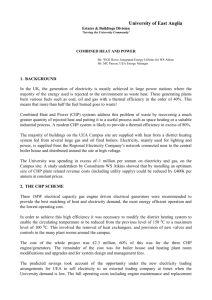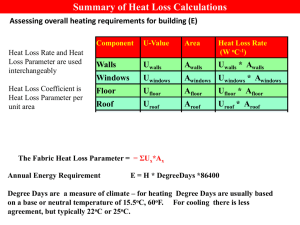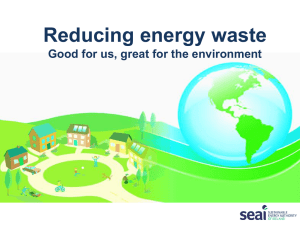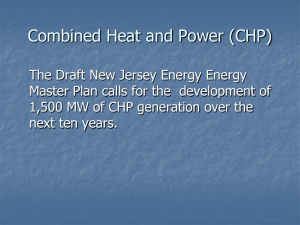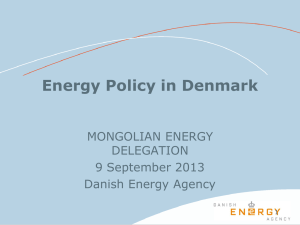NBS-3B1Y Strategic Corporate Sustainability
advertisement
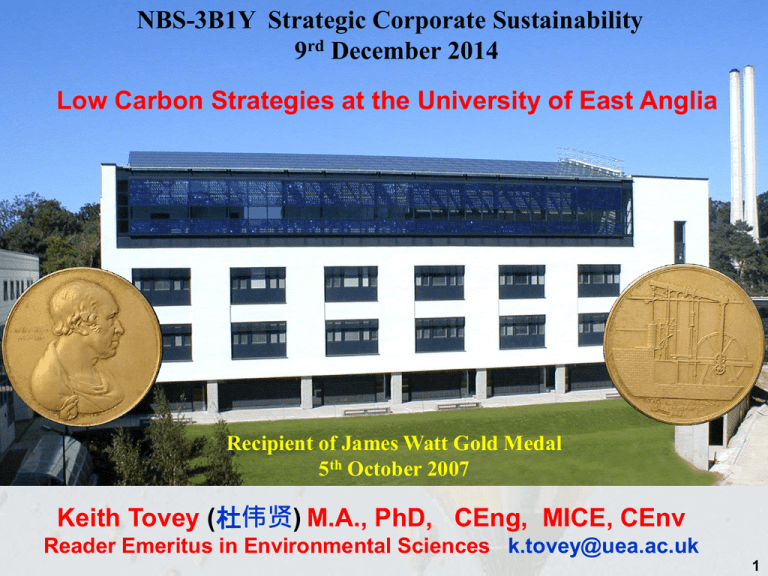
NBS-3B1Y Strategic Corporate Sustainability 9rd December 2014 Low Carbon Strategies at the University of East Anglia Recipient of James Watt Gold Medal 5th October 2007 Keith Tovey (杜伟贤) M.A., PhD, CEng, MICE, CEnv Reader Emeritus in Environmental Sciences k.tovey@uea.ac.uk 1 NBS-3B1Y Strategic Corporate Sustainability Access to this presentation and numerous links relating to Energy may be found at http://www2.env.uea.ac.uk/energy/energy.htm or http://www.uea.ac.uk/~e680/energy/energy.htm 2 NBS-3B1Y Strategic Corporate Sustainability • Links to Energy Related Sites • Powerpoint Presentation of Energy Supply at UEA and Strategies for Low Carbon at UEA [this presentation] • Video Clips of Biomass System and also Carbon Footprinting of BBC Studios - [given today] • Powerpoint of challenges facing UK Energy Supply – [given tomorrow] • Recent Government Documents on Energy including Consultations and responses by N.K.Tovey • Papers written by N.K. Tovey relating to Energy and Carbon including reports on UEA Energy • Sustainability Report relating to several branches of an International Bank. • Return to Main UEA Energy Page 3 Low Carbon Strategies at the University of East Anglia • Today’s Session • Introduction and Background to Energy Supply at UEA • Low Energy Buildings and their Management • Low Carbon Energy Provision – Photovoltaics, CHP, Adsorption chilling – Biomass Gasification • Tomorrow’s Session • Energy Security: Hard Choices facing the UK • The Energy Tour – ensure you are not wearing open sandals/shoes – Elizabeth Fry building & ZICER • Questions & Answers • If time permits: - FRACKING – A solution to UK Energy Problems or an unacceptable step too far? 4 Original buildings Teaching wall Library Student residences 5 History of Energy Supply at UEA • Early 1960s: central boiler house built with three 8MW boilers providing water at 105 – 115o C at 10 bar pressure to circulate around the campus. • Fuel used: heavy residual oil • 1984: small 4 MW boiler was added • 1987: interruptible gas was provided so boiler could run on either heavy fuel oil or gas. • 1997/8: one 8 MW boiler removed and 3 1 MW CHP plants installed • 2002: remaining heavy fuel oil provision converted to light oil • 2006: Absorption Chiller installed • 2010: Biomass Plant installed • Most buildings on campus have heat provision from central boiler house. – Exceptions: Elizabeth Fry, Queens, EDU, Nelson Court, Constable Terrace. 6 Nelson Court楼 Constable Terrace楼 7 Low Energy Educational Buildings Nursing and Midwifery Thomas Paine Study Centre School Medical School Phase 2 ZICER Elizabeth Fry Building Medical School 8 Constable Terrace - 1993 • Four Storey Student Residence • Divided into “houses” of 10 units each with en-suite facilities • Heat Recovery of body and cooking heat ~ 50%. • Insulation standards exceed 2006 standards • Small 250 W panel heaters in individual rooms. Electricity Use Carbon Dioxide Emissions - Constable Terrace 12% 21% 140 Appliances 120 Lighting 100 MHVR Fans MHVR Heating 18% Panel Heaters Hot Water 18% Kg/m2/yr 14% 80 60 40 20 0 17% UEA Low Medium 9 Educational Buildings at UEA in 1990s Queen’s Building 1993 Elizabeth Fry Building 1994 Elizabeth Fry Building Employs Termodeck principle and uses ~ 25% of Queen’s Building 10 The Elizabeth Fry Building 1994 Cost ~6% more but has heating requirement ~20% of average building at time. Significantly outperforms even latest Building Regulations. Runs on a single domestic sized central heating boiler. 11 2 Toplam Enerji Tüketimi (kWh/m /yıl) Conservation: management improvements 140 120 Heating/Cooling Hot Water Electricity 100 80 60 40 20 0 1995 1996 1997 1998 1999 2000 2001 2002 2003 2004 Careful Monitoring and Analysis can reduce energy consumption. . 12 Comparison with other buildings 250 gas electricity thermal comfort +28% 150 2 kWh/m /yıl 200 User Satisfaction 100 50 0 Elizabeth Fry Low Energy Energy Performance Average air quality +36% lighting +25% noise +26% A low Energy Building is also a betterDioxide place toPerformance work in. Carbon 13 ZICER Building Won the Low Energy Building of the Year Award 2005 • Heating Energy consumption as new in 2003 was reduced by further 57% by careful record keeping, management techniques and an adaptive approach to control. • Incorporates 34 kW of Solar Panels on top floor 14 The ground floor open plan office The first floor open plan office The first floor cellular offices 15 The ZICER Building – Main part of the building • High in thermal mass • Air tight • High insulation standards • Triple glazing with low emissivity ~ equivalent to quintuple glazing 16 Operation of Main Building Mechanically ventilated that utilizes hollow core ceiling slabs as supply air ducts to the space Incoming air into the AHU Regenerative heat exchanger 17 Operation of Main Building Filter 过滤器 Heater 加热器 Air passes through hollow cores in the ceiling slabs 空气通过空心的板层 Air enters the internal occupied space 空气进入内部使用空间 18 Operation of Main Building Recovers 87% of Ventilation Heat Requirement. Space for future chilling 将来制冷的空间 Out of the building 出建筑物 The return air passes through the heat exchanger 空气回流进入热交换器 Return stale air is extracted from each floor 从每层出来的回流空气 19 Fabric Heating/Cooling: Importance of Hollow Core Ceiling Slabs Hollow core ceiling slabs store heat and cool at different times of the year providing comfortable and stable temperatures Warm air Winter Day Warm air Heat is transferred to the air before entering the room Slabs store heat from appliances and body heat. 热量在进入房间之前被传递 到空气中 板层储存来自于电器以及人 体发出的热量 Air Temperature is same as building fabric leading to a more pleasant working environment 20 Fabric Heating/Cooling: Importance of Hollow Core Ceiling Slabs Hollow core ceiling slabs store heat and cool at different times of the year providing comfortable and stable temperatures Cold air Winter Night Heat is transferred to the air before entering the room Slabs also radiate heat back into room In late afternoon heating is turned off. 热量在进入房间之前被传递到 空气中 板层也把热散发到房间内 Cold air 21 Fabric Heating/Cooling: Importance of Hollow Core Ceiling Slabs Hollow core ceiling slabs store heat and cool at different times of the year providing comfortable and stable temperatures Cool air Summer night Draws out the heat accumulated during the day Cools the slabs to act as a cool store the following day night ventilation/ free cooling 把白天聚积的热量带走。 冷却板层使其成为来日的冷 存储器 Cool air 22 Fabric Heating/Cooling: Importance of Hollow Core Ceiling Slabs Hollow core ceiling slabs store heat and cool at different times of the year providing comfortable and stable temperatures Warm air Summer day Slabs pre-cool the air before entering the occupied space concrete absorbs and stores heat less/no need for air-conditioning 空气在进入建筑使用空间前被 预先冷却 混凝土结构吸收和储存了热量 以减少/停止对空调的使用 Warm air 23 Energy Consumption (kWh/day) 能源消耗(kWh/天) Good Management has reduced Energy Requirements Space Heating Consumption reduced by 57% 1000 800 800 600 400 350 200 0 -4 -2 0 2 4 6 8 10 12 14 16 18 Mean |External Temperature (oC) Original Heating Strategy New Heating Strategy 原始供热方法 新供热方法 24 Life Cycle Energy Requirements of ZICER compared to other buildings 与其他建筑相比ZICER楼的能量需求 自然通风 221508GJ 54% 28% 51% 使用空调 384967GJ 34% 建造 209441GJ Materials Production 材料制造 Materials Transport 材料运输 On site construction energy 现场建造 Workforce Transport 劳动力运输 Intrinsic Heating / Cooling energy 基本功暖/供冷能耗 Functional Energy 功能能耗 Refurbishment Energy 改造能耗 Demolition Energy 拆除能耗 29% 61% 25 Life Cycle Energy Requirements of ZICER compared to other buildings 300000 ZICER 250000 Naturally Ventilated GJ 200000 Air Conditrioned 150000 100000 50000 0 0 5 10 15 20 25 30 35 40 45 50 55 60 80000 Years GJ 60000 Compared to the Air-conditioned office, ZICER as built recovers extra energy required in construction in under 1 year. 40000 20000 ZICER Naturally Ventilated Air Conditrioned 0 0 1 2 3 4 5 6 7 8 9 10 Years 26 Low Carbon Strategies at the University of East Anglia • Low Energy Buildings and their Management • Low Carbon Energy Provision – Photovoltaics – CHP – Adsorption chilling – Biomass Gasification • The Energy Tour • Energy Security: Hard Choices facing the UK 27 ZICER Building Photo shows only part of top Floor • Mono-crystalline PV on roof ~ 27 kW in 10 arrays 28 • Poly- crystalline on façade ~ 6.7 kW in 3 arrays Performance of PV cells on ZICER Wh % 100 100 Block1 90 90 Block 2 80 80 Block 3 70 70 Block 4 60 60 Block 5 50 50 Block 6 40 40 Block 7 30 30 Block 8 20 20 Block 9 10 10 Block 10 0 0 radiation 9 10 11 12 13 14 All arrays of cells on roof have similar performance respond to actual solar radiation 15 Time of day % Wh The three arrays on the façade respond differently 200 180 160 140 120 100 80 60 40 20 0 100 90 80 70 60 50 40 30 20 10 0 9 10 11 12 13 Time of Day 14 15 Top Row Middle Row Bottom Row radiation 29 Elevation in the sky (degrees) 20 18 16 14 12 10 8 6 4 2 0 120 8.00 9.00 150 10.00 180 210 12.00 13.00 14.00 Orientation relative to True North 11.00 15.00 240 16.00 30 Elevation in the sky (degrees) 25 January May September P1 - bottom PV row February June October P2 - middle PV row March July November P3 - top PV row April August December 20 15 10 5 0 6.00 7.00 8.00 9.00 10.00 11.00 12.00 Time (hours) 13.00 14.00 15.00 16.00 31 Arrangement of Cells on Facade Individual cells are connected horizontally Cells active Cells inactive even though not covered by shadow As shadow covers one column all cells are inactive If individual cells are connected vertically, only those cells actually in shadow are affected. 32 32 Use of PV generated energy Peak output is 34 kW 峰值34 kW Sometimes electricity is exported Inverters are only 91% efficient • Most use is for computers • DC power packs are inefficient typically less than 60% efficient • Need an integrated approach 33 Conversion efficiency improvements – Building Scale CHP 3% Radiation Losses 11% 61% Flue Flue Losses Losses 36% 86% Gas Localised generation makes use of waste heat. Reduces conversion losses significantly Exhaust Heat Exchanger Engine Heat Exchanger Generator 36% Electricity 50% Heat 34 UEA’s Combined Heat and Power 3 units each generating up to 1.0 MW electricity and 1.4 MW heat 35 Conversion efficiency improvements Before installation 1997/98 MWh electricity gas oil 19895 35148 33 Total Emission factor kg/kWh 0.46 0.186 0.277 Carbon dioxide Tonnes 9152 6538 9 Electricity After installation 1999/ Total CHP export 2000 site generation MWh 20437 15630 977 Emission kg/kWh -0.46 factor CO2 Tonnes -449 15699 Heat import boilers CHP oil total 5783 14510 28263 923 0.46 0.186 0.186 0.277 2660 2699 5257 256 10422 This represents a 33% saving in carbon dioxide 36 Conversion efficiency improvements Load Factor of CHP Plant at UEA Demand for Heat is low in summer: plant cannot be used effectively More electricity could be generated in summer 37 绝热 Heat rejected 高温高压 High Temperature High Pressure 节流阀 Throttle Valve Compressor 冷凝器 Condenser 蒸发器 Evaporator 低温低压 Low Temperature Low Pressure 压缩器 为冷却进行热提 取 Heat extracted for cooling A typical Air conditioning/Refrigeration Unit 38 Absorption Heat Pump 外部热 Heat from external source 绝热 Heat rejected 高温高压 High Temperature High Pressure 吸收器 Desorber 节流阀 Throttle Valve 冷凝器 Condenser 蒸发器 Evaporator 为冷却进行热提 取 Heat extracted for cooling 低温低压 Low Temperature Low Pressure 热交换器 Heat Exchanger W~0 吸收器 Absorber Adsorption Heat pump reduces electricity demand and increases electricity generated 39 A 1 MW Adsorption chiller 1 MW 吸附冷却器 • Uses Waste Heat from CHP • provides most of chilling requirements in summer • Reduces electricity demand in summer • Increases electricity generated locally • Saves ~500 tonnes Carbon Dioxide annually 40 The Future: Biomass Advanced Gasifier/ Combined Heat and Power • • • • • Addresses increasing demand for energy as University expands Will provide an extra 1.4MW of electrical energy and 2MWth heat Will have under 7 year payback Will use sustainable local wood fuel mostly from waste from saw mills Will reduce Carbon Emissions of UEA by ~ 25% despite increasing student numbers by 250% 41 Trailblazing to a Low Carbon Future Low Energy Buildings Low Energy Buildings Photo-Voltaics • Low Energy Buildings • Absorption Chilling • Effective Adaptive Energy Management • Advanced CHP using Biomass Gasification • Photovoltaics Efficient CHP • Combined Heat and Power Absorption Chilling • World’s First MBA in Strategic Carbon Management 42 42 42 Trailblazing to a Low Carbon Future Photo-Voltaics Efficient CHP Advanced Biomass CHP using Gasification Absorption Chilling 43 43 43 Trailblazing to a Low Carbon Future Efficient CHP 1990 2006 Students Floor Area (m2) 5570 138000 CO2 (tonnes) CO2 kg/m2 CO2 kg/student Absorption Chilling 14047 207000 Change since 1990 +152% +50% 2010 16000 220000 Change since 1990 +187% +159% 19420 140.7 21652 104.6 +11% -25.7% 14000 63.6 -28% -54.8% 3490 1541 -55.8% 875 -74.9% 44 44 44 Conclusions • Effective adaptive energy management can reduce heating energy requirements in a low energy building by 50% or more. • Heavy weight buildings can be used to effectively control energy consumption • Photovoltaic cells need to take account of intended use of electricity use in building to get the optimum value. • Building scale CHP can reduce carbon emissions significantly • Adsorption chilling should be included to ensure optimum utilisation of CHP plant, to reduce electricity demand, and allow increased generation of electricity locally. • Promoting Awareness can result in up to 25% savings • When the Biomass Plant is fully operational, UEA will have cut its carbon emissions per student by over 70% since 1990. Finally! "If you do not change direction, you may end up where you are heading." Lao Tzu (604-531 BC) Chinese Artist and Taoist philosopher 45
